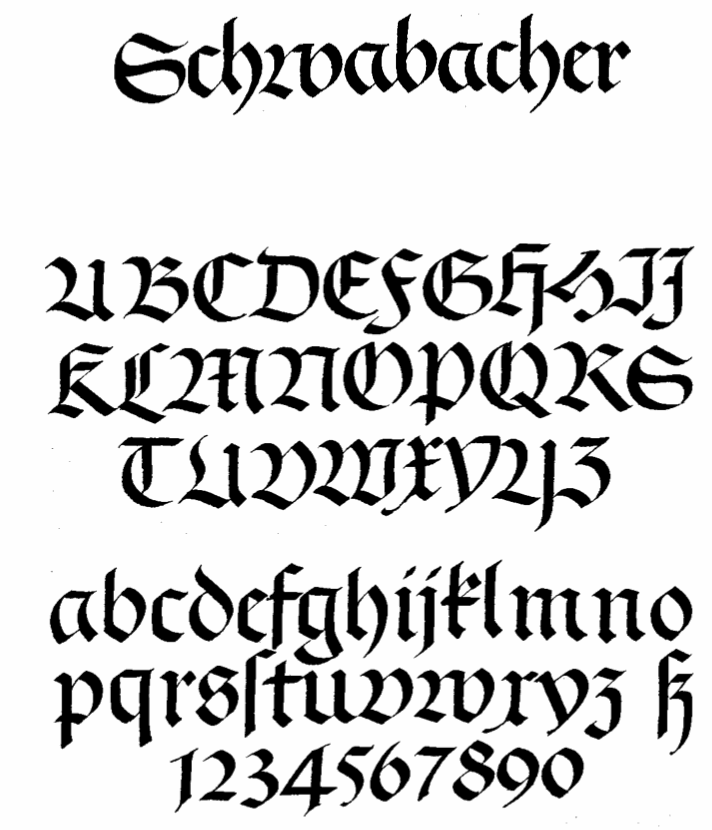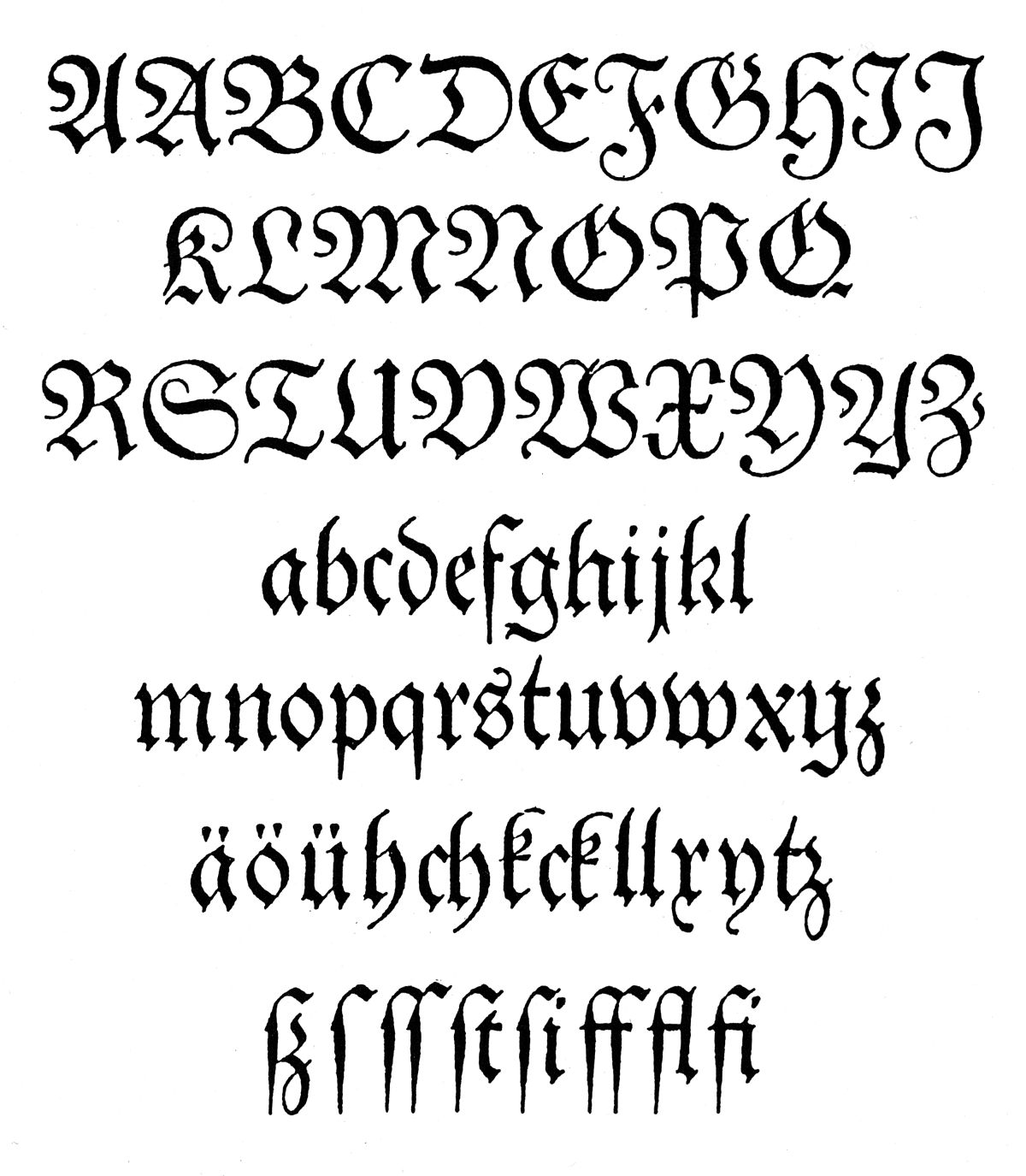A Brief History of Fraktur

Fraktur quickly overtook the earlier Schwabacher and Textualis typefaces in popularity, and a wide variety of Fraktur fonts were carved and became common in the German-speaking world and areas under German influence (Scandinavia, the Baltic states, Central Europe). Ehmcke-Schwabacher Initialen byTypographer Mediengestaltung. Leipzig Fraktur +4 byPeter Wiegel. Download Donate. Moderne Schwabacher +2 byPeter Wiegel. Download Donate. Schwabacher byTypographer Mediengestaltung. Schwaben Alt byPeter Wiegel. Download Donate.
Schwabacher Fraktur Font
At the end of the 15th century most Latin books in Germany were printed in a dark, barely legible gothic type style known as Textura. What little was printed in German used the rougher and more base Schwabacher type.
When the German emperor Maximilian (reigned 1493-1517) decided to establish a splendid library of printed books, he directed that a new typeface be created especially for this purpose. This typeface was to be more elegant than the boorish Schwabacher, more modern than the gothic Textura and yet distinctly “German” in that it should not incorporate elements of the Antiqua style typefaces that the humanist movement had just created in Italy based on ancient roman lettering, and which had become the rage of printing fashion south of the Alps. Based on the Bastarda handwriting used by the scribes of the Emperor’s chancery, the calligrapher Leonhard Wagner designed this new typeface, which soon became known as Fraktur (say frac-toor) for the broken character of its lines. Only four of Maximilian’s 130 planned editions were completed in his lifetime, but those four had been sent for illustration to the foremost German renaissance artists, Dürer, Cranach and Grün. The artists used the new typeface in their works and thus gave it a wide distribution. Albrecht Dürer’s “Unterweysung” is still one of the most famous books printed in Fraktur.
When the reformation movement swept across Germany, a flood of printed propaganda came with it. Much of this material used the new Fraktur and helped to make the new type popular far and wide. It allowed for an easy distinction of catholic and protestant publications: The protestants printed German, using Fraktur, the Catholics printed Latin, using Antiqua types similar to the one used here. One edition of the Bible even had each verse start with a Fraktur letter when the topic was salvation or other positive events, but Antiqua when it was Satan, hell, and eternal damnation. It was this separation that caused Fraktur to be known as the “German” and Antiqua as the “Latin” font. For the next five centuries, the Germans managed to hold on to the ancient Fraktur, swaying between unanimous support of it and cursing the “outdated monkish scribbles” depending on the current level of national sentiment. Most works intended for a general audience continued to be printed this way well into the 20th century, while books of a more scientific nature used the “learned” Latin type.

In the meantime, most other European countries adopted Antiqua and still use it to this day. After World War I Fraktur finally began to go out of style as German society became more cosmopolitan and open to international influences. This ended with the rise of the Third Reich and the ensuing glorification of everything German. Many pseudo-Fraktur and Gothic types were created then, most displaying the harsh spirit of the “New Germany” and most of them incredibly ugly.
Schwabacher Frakturschrift
Ironically it was Hitler himself who finally terminated Fraktur printing. During the course of the war, the German type had proved to be a communications barrier with the peoples of occupied Europe, and so in January of 1941, Fraktur was officially abolished by declaring it to be “Un-German” and “of Jewish origin'. The order directed all newspapers and publishing houses to switch to Antiqua at the earliest practicable date. Due to the economic difficulties caused by the war, this date never really came, and relatively few publications had actually switched by the end of the war in 1945. The occupying allied forces naturally imposed a censorship on printed materials and further encouraged the use of Antiqua typefaces for reasons of legibility.
In the following years, German printers and type designers looked for new directions that were not reminiscent of Germany’s militarist past, and eventually developed a style similar to the Bauhaus designs of the 1920’s. During the next forty years, Fraktur became closely and solely associated with the Third Reich. All Fraktur printing was treated with suspicion.
Today, printers and type designers are carefully pulling these treasures back into the light and hope that they will once again be freed of political sentiments. We hope to contribute our share by making 18 of the most beautiful Fraktur and handwriting fonts available to you, and we invite you to enjoy this new, old, beautiful way of putting thoughts on paper.
Schwabacher Fraktur Font
Please take a moment to browse our collection of beautiful, authentic Fraktur fonts, The Gutenberg Press. It allows you to experience Fraktur for yourself, and to employ it in your own projects. The collection includes Fraktur fonts from five centuries, but all are relevant and perfectly usable today.
